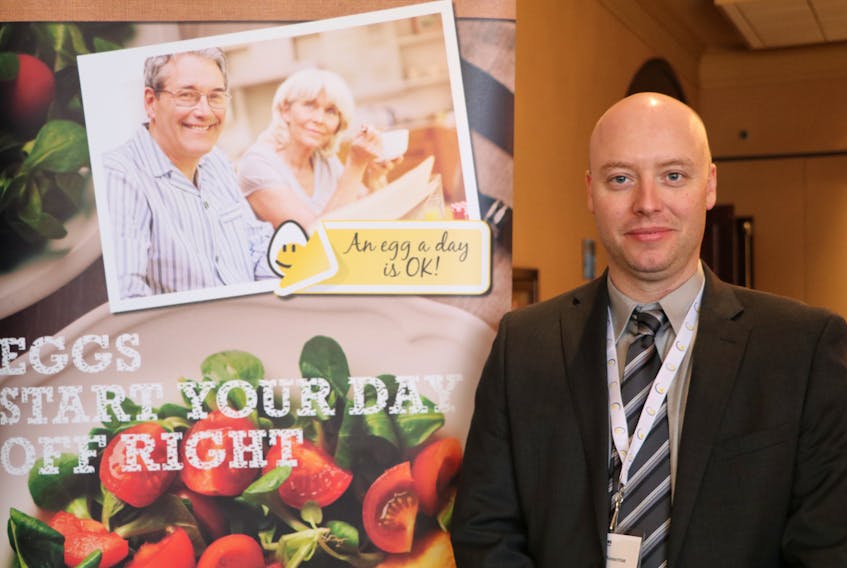There are about 120 million eggs laid in Newfoundland and Labrador each year, according to the Egg Farmers of Newfoundland and Labrador website.
That’s a lot of eggtivity, and enough to supply the island part of the province’s egg market and more.
Staying competitive with egg producers in other provinces, however, is a challenge. Exporting eggs, and importing hen feed and supplies on Marine Atlantic ferries, ramps up costs.
“As a producer, the biggest problem that we would have is our geographical location. That makes it awful challenging to do some things, especially around feed-related things,” said Curtis Somerton, chairman of the Egg Farmers of Newfoundland and Labrador.
“We have a real shortage of finished feeds in this province and it’s really challenging to get finished feeds into this province given the Marine Atlantic situation.”
Somerton is a third-generation egg farmer. His grandfather started the Munn Poultry Farm in Portugal Cove 50 years ago and the family moved the farm to the Ocean Pond area, just east of Whitbourne, in 2004 to build a state-of-the-art facility. Somerton, his wife, Crystal, and his mother, Leslie, all work on the farm.
Somerton said egg farmers cannot obtain proper hen feed in the province because of the climate. New crop research ongoing in the province is providing some hope that eventually there may be suitable local feed produced.
“We are a little different than dairy. Dairy can use raw grains in their rations, whereas in the poultry business we have to use a real dry ration. You need to have a certain amount of dry matter to mill feed,” he said. “It’s the ingredients that go into it. The corn needs to be a certain moisture, soya beans need to be a certain moisture in order to mill it and store it, and it has to have low moisture content. In Newfoundland, with our climate, that makes it real challenging.”
The Egg Farmers of Newfoundland and Labrador is a commodity board governing the production of eggs in the province. According to its website, each province of Canada has a provincial egg board comprised of a board of directors and a local board office. The Egg Farmers of Canada governs the egg industry of Canada.
Each provincial board operates under a levy system. Levies are collected on a per-bird basis from each producer in every province and allows for the day-to-day operation of the local boards and the operation of Egg Farmers of Canada and its programs. Quotas for egg production are allocated by the federal body.
The Egg Farmers of Newfoundland and Labrador held its annual general meeting in St. John’s Tuesday, with the guest speaker being Minister of Fisheries and Land Resources Gerry Byrne.
“The work (farmers) do is important. We take food for granted a lot in this province because it’s readily available to us from so many sources,” Byrne said. “Often people think — and many of us are guilty of it — that eggs come from a cardboard container, milk comes from a container, and steak and meat and chicken come from a styrofoam plate.
“Often we forget or don’t remind ourselves that food and food production is central to who we are, not only for our own safety and security, but for the jobs it provides.”
Byrne said it is important for him to meet with and talk to egg producers directly about their concerns and potential opportunities.
“We are working with the Egg Farmers of Newfoundland and Labrador to establish an operation in Labrador,” Byrne said. “Most of the egg market in Labrador is supplied from Cape Breton.
“Our egg farmers literally produce five million cartons of eggs which they actually transport to Quebec for industrial production.”
Byrne said he has been working to address the issues with Marine Atlantic that are key to helping local egg farmers become and remain competitive with their counterparts in other provinces.
“Marine Atlantic is very important to our overall competitiveness,” he said. “But we are being hindered by Marine Atlantic’s schedule, reliability and costs.
“The fuel surcharge at Marine Atlantic does not pass the test at all.”
In January, Marine Atlantic announced its rate structure for 2018-19, and increased the fuel surcharge from 15 per cent to 18 per cent.
Byrne has questioned if the fuel surcharge is really about complying with international environmental regulations adopted by the federal government as Marine Atlantic indicated, or about the cost of fuel.
Byrne said that according to his research and information, the fuel surcharge is inappropriate. He said he is lobbying the federal government to remove the charge.
“I provided evidence that Marine Atlantic’s fuel costs are the lowest ever in 15 years and yet they are imposing an 18 per cent fuel surcharge.”
Byrne also said his department is working to increase the province’s food self-sufficiency by increasing local production from 10 per cent of the food consumed in the province to 20 per cent by 2022.
One way of doing that is increasing land availability.
“For the first time ever, we’ve identified 64,000 hectares of agricultural land that is now available and targeted for agricultural production. We have a new Canadian agricultural partnership agreement signed with the federal government that we are about to launch with just over $37 million over a five-year period to fund and support innovation and production,” he said.
“We have tremendous potential. We do produce a significant volume of root crops, but we don’t produce what we consume. Those are things that we can target for specific, immediate expansion in our agricultural production.”









